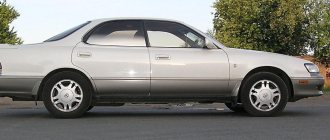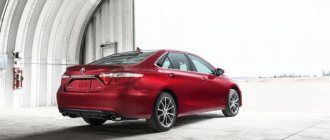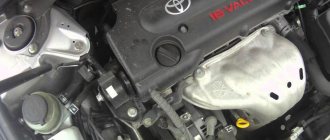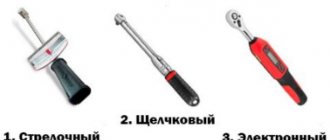On-site inspection
A discreet, yet easily recognizable design. Narrow elongated rear lights are reminiscent of the lighting technology of some European models. The front end looks powerful and solid. The trunk lid is crowned with the promising “V6” nameplate. Under the hood, indeed, there is a V6, albeit of a modest volume.
The spoiler on the trunk lid and two-tone color give the car elegance. The door windows have no frames, which is very common among Japanese cars. At the same time, despite its great age, the glass does not rattle during movement, which means that the power structure of the door is well designed.
The salon is a symbiosis of many models. The instrument panel is from larger and more expensive modifications. Instead of the usual dial gauges, there is a narrow dark “embrasure” in front of your eyes, which “comes to life” only when the ignition is turned on. In the center is a digital speedometer. Below, horizontally, there is a digital tachometer scale. Along the edges are electronic indicators of fuel level and fluid temperature in the cooling system.
The instrument panel is quite massive and well laid out. The interior of the car is in perfect harmony with its appearance. The interior is made with special care - the quality of parts and their fit are at a high level. The plastic trim looks solid. On the “beard” there is microclimate control and a stereo system. The climate control does not have a display to display the operating mode, but its control is very clear and simple (at least easy to use).
The car interior is spacious enough for four tall people. If desired, a third passenger can fit in the back seat, but he is unlikely to like the hard middle section of the seat.
The driving position is good. There is enough space, the range of all adjustments, including adjustment of the steering column in angle and length, is more than sufficient. And only the height of the driver's seat is not adjustable in such a wide range as expected.
On the run
The V-shaped two-liter “six” copes with its duties perfectly. Acceleration is smooth, confident, like a locomotive, without pronounced pick-ups. The automatic transmission operates very smoothly – the shifts are noticeable if you follow the tachometer needle.
At first, I was slightly confused by the “laziness” with which the car started from a standstill (even with the sports mode in the “box” engaged). Only after the “automatic” switched to second gear did acceleration become more or less vigorous. It turned out... you need to press harder on the gas pedal (“at the end” its movement is difficult and some effort is required). We pressed it - the car demonstrated quite decent acceleration dynamics.
I liked the performance of the suspension. The car drives smoothly. The suspension easily “swallows” gentle “waves”, very significant potholes, potholes and seams, without transmitting excessive swing to the cabin.
The brakes left pleasant memories. A soft, very informative pedal allows you to brake with pinpoint precision even on slippery roads. ABS intervenes very correctly only at the very last moment.
The Camry Prominent is a pleasure to drive. The steering rear wheels make the turning circle amazingly tight. This is precisely the case when the expression “turn around on your heels” should be taken literally.
But, in theory, the 4WS system should also work when changing lanes. The algorithm is something like this: when you turn the steering wheel slightly (as is usually done when overtaking), the rear wheels turn in the same direction as the front ones. When making large turns of the steering wheel, such as when parking or making a U-turn, the rear wheels should turn in the opposite direction. Typically, on vehicles with electronically controlled 4WS, countersteering of the rear wheels can be disabled. However, in this case, manipulations with the corresponding “Revs 2WS” button did not produce any results. Which, however, did not in any way affect the driving performance.
On a sharp turn, the car holds the road clearly and skids only if you “help” it.
The steering deserves good words about it. Despite the steering of the rear wheels, the car's reactions are quite understandable and predictable. In the near-zero zone, the reactive force on the steering wheel is not felt. And with small turns of the steering wheel, the car reluctantly changes its trajectory. But as soon as you turn the steering wheel a little, the car instantly changes its trajectory.
Comparison with “classmates”
This market segment is quite crowded: there is a very stubborn struggle for the buyer’s wallet. And the main “fighters”, perhaps, are the Toyota Camry ($7,250)* and Audi 100 ($6,300). In addition, Mercedes W124 ($8,050), BMW 5 ($5,900), Opel Omega ($4,000), Nissan Maxima ($4,750) are also presented here. Toyota Camry Prominent (no data), by and large, is not much inferior to the listed cars. Unless you should take into account the right-hand steering position.
* The average offer price is indicated according to the block of free private advertisements of the newspaper “Wheels” at the time of publication of the article
Evgeniy KARIMOV. Photo by Anatoly GORNOSTALEV
up
Second generation
In 1990, the Japanese automaker presented to the public the second generation of the already critically acclaimed luxury Camry model. Externally, the Prominent was very similar to the Vista hardtop, with only a few details differing. The only thing is that the 1992 Camry Prominent received smoother body lines, thanks to which the flagship looked even more solid
In its second generation, Prominent continued to be equipped with V-shaped 6-cylinder 1VZ-FE engines, until the main role passed to a new power unit - a 2.5-liter V6 4VZ-FE with a maximum torque of 224 Nm at 4800 rpm. , which after restyling in 1992 became the only engine for this model.
Power unit V6 4VZ-FE in the engine compartment of Toyota Camry Prominent V30
The 1VZ-FE internal combustion engine was installed on Prominent until 1992, since the 4VZ-FE unit turned out to be preferable, mainly due to its larger volume and increased power. In general, both the first and second motors are structurally the same, with the exception of volume.
In general, the new engine has proven itself on the positive side, but just like its predecessor, it turned out to be extremely demanding in terms of maintenance, as well as the quality of gasoline and oil. If problems appeared in the 4VZ-FE cooling system, accelerated wear of the installation did not take long to occur.
| 4VZ-FE | |
| Volume, cm3 | 2496 |
| Power, hp | 175 |
| Consumption, l/100 km | 5.7-11.2 |
| Ø cylinder, mm | 87.5-88 |
| CC | 09.06.2010 |
| HP, mm | 69.2 |
| Models | Camry Prominent (V30), Windom |
| Resource, thousand km | 300+ |
"White bird"
As the name suggests, the Camry Prominent is a close relative of the Camry, but at the same time it can easily be confused with the Vista sedan. The Japanese produce such a large number of car models for their loved ones that it’s easy to get confused in them.
The snow-white metallic paint in which this car is painted is highlighted by a silver “belt” that includes bumpers and side trims. The radiator lining is decorated with a stylized image of a bird – the “wings” and sharp “beak” are clearly “readable”. Maybe that's why the Camry Prominent is associated with a white bird.
The Camry Prominent's interior seems almost entirely borrowed from the Camry, but there are still differences. The first thing that catches your eye is the dashboard. It is made in the form of a large liquid crystal display. I didn’t bother to understand the intricacies of the graphic images; I noted only a few of its elements: a speedometer, a clearly readable automatic transmission range scale and a long tachometer strip.
On the center console I found retractable cup holders and several lockable containers of varying sizes. Under the central armrest I found a very spacious box, consisting of two parts (the second is intended for rear seat passengers and has a separate lid).
In order to get back, you need to bend your head, since the doorway at the top is very narrowed for the sake of aerodynamics or aesthetics. The back seat is comfortable, but a third seat will fit here only as a last resort. But another feature of this seat is very practical - its back can be folded either entirely or in parts. This solution is typical for cars with a station wagon or hatchback body, but for a sedan it is a rather unexpected convenience.
Toyota Camry Prominent / Toyota Camry Prominent
Camry Prominent: parameters, tests (test drive, crash test), reviews, car dealerships, photos, videos, news.
Toyota Camry Prominent
— production began in 1990. The quality of Camry Prominent has been tested by time and recognized by car owners.
The car has not sunk into history like many other, less successful models. Among the existing basic colors of the Camry Prominent, you can easily find one that suits you, but most likely you can choose it to order. We most likely do not have all the configurations of this Toyota Camry Prominent model, among which there are various options for assembling the Camry Prominent: the gearbox can be automatic or manual, interior trim with leather or wood inserts, wheels and other additional elements of the Camry Prominent body, which are certainly will be reflected in the price of the Camry Prominent. The technical characteristics are good, but do not forget about the safety of the Camry Prominent or the engine size, which will then make itself felt in terms of operating costs in the future, as well as Camry Prominent repairs and maintenance with a warranty period. Since the purchase is made not for several months, but for several years, so consider for yourself what you will do in the summer and winter, what trips you will make in the Camry Prominent
. The table below shows a comparison of several configurations of the Camry Prominent, the parameters include: what are the overall dimensions of the Camry Prominent, what is the fuel consumption in the city, highway or mixed, engine size, maximum speed and acceleration time to 100 km/h, curb or gross weight Camry Prominent, wheelbase, front and rear wheel tracks, transmission type (gearbox/gearbox), what drive, tire size, what horsepower or torque and what price. In addition to all the numbers, you can read reviews of car owners about the Camry Prominent, watch videos or news, tests (test drive, crash test).
Three liters and full controllability
Three liters of V-shaped “six” provide the Camry Prominent with a good supply of vigor. The large displacement allows the driver liberties that are not comparable to the status of a respectable sedan. The engine does not require cranking up to high speeds; it is quite flexible at the “lower” levels. But if you sharply press the accelerator pedal, the engine will very dynamically “throw” the car forward. The automatic transmission is well suited to the character of the engine, and if you use the so-called sport mode, the Prominent turns into a wild “beast”.
Despite the fighting spirit, the Toyota Camry Prominent remains a very comfortable sedan. The suspension copes well with road troubles without disturbing the peace of the driver and passengers. The shock absorbers, like the gearbox, have a sport mode, in which the car behaves a little stiffer, but handles a little better.
The Camry Prominent's steering has one feature - four-wheel drive (4WS). In reality, it looks like this - when you turn the steering wheel, the rear wheels turn at a small angle in the direction opposite to the turn of the front wheels. This significantly reduces the turning radius and helps with maneuvering.
Folk retro. 1991 Toyota Camry Prominent VZV30. Symbol of prosperity
The Japanese cloning of models in the late 80s and early 90s, even without taking into account any kind of badge engineering, seems to have reached a dead end. What was the point of churning out essentially identical bodies on the same platform and with the same technical filling under different names? Well, yes, that was what the client, who had become rich and did not delve too deeply into the design details, demanded. Well, there were also consumers who knew how to count cylinders and knew the meaning of the saying “The same eggs, only in profile.” For such erudite people, Toyota still offered something special - a sedan with V-twin engines instead of in-line ones.
Strictly speaking, according to the Japanese classification it was not a sedan, but a hardtop. But we know what island firms often meant by this concept. Just glass without frames with central roof pillars. Same eggs... However, without the flagship Prominent, the V30 family, which appeared in 1990, would have looked like other Toyota and Japanese clones in general. Let us remember that under two different names - Camry and Vista - then essentially the same car was offered, differing literally in the little things.
Top Camry, bottom Vista
The situation was saved by the “other” Vista on this base - “frameless”.
Moreover, compared to the sedans, this “hardtop” looked like a geisha next to a collective farmer - pretty, elegant. The main thing is absolutely recognizable. It is logical that Prominent (English: prominent, noticeable) was performed in this particular body. I remember that even several years after cars of the V30 generation came to our country en masse, the flagship of the family, in comparison with the “worker-peasant” Camry/Vista, was perceived almost as a separate model. It cost more and attracted a certain exclusivity. It was believed that ordinary sedans and hardtops were like an ordinary level. And Prominent with its “fog” lenses is a real “business”, for the purchase of which it would be better to have... your own business.
The idea to offer a V6 on a front-wheel drive E-Class model did not come to Toyota while preparing the V30 family. Previously - on the previous generation. We were preparing for expansion in the States, which was successfully carried out in the late 80s with the Lexus ES (Camry/Vista V20). And your own internal client has matured. So our heroine in this format only inherited the success of her parent. Although it brought a technical update. If the Prominent of the mid-80s had only a 2.0-liter V6 1VZ-FE (140 hp), then the second generation plus a 2.5-liter six 4VZ-FE (175 hp). Like the overseas ES and Camry, also intended exclusively for North America.
In addition to older engines, the status was supported by expanded equipment. Of course, now those positions for which they asked for a couple of hundred thousand extra yen make you smile. At the same time, cruise control, a radio key, vibration cleaning of mirrors, an ionizer, and an electric driver's seat were not at all considered something commonplace.
In the 90s, the ionizer on the “Japanese” was almost the personification of belonging to the “premium”But from a technical point of view, besides, of course, the engines, the Prominent was not anything outstanding. No, he relied on both 4WS (rear wheel steering system) and TEMS (shock absorbers with adjustable stiffness), despite the fact that the suspension design was identical. However, no “fours” (status!), diesels (I support! 2C-T was a bad fit even for regular Camry/Vista) and all-wheel drive. In the early 90s, Toyota generally regarded the latter as something utilitarian and usually did not offer it on the “upper” models.
And yet, perhaps, it’s more of a pity that the company did not consider it necessary to bring the interior in line with the image. This financial luxury went only to Windom, created on the same basis and appeared a year later. It also had an “optitron” and screens in the “climate” block.
And the Prominent has the same “grandmother’s chest of drawers” as the sedans. With colors ranging from “soft black” to “deep beige”. We have an intermediate option. No less gloomy than the first, and just as dull as the second.
The instruments were ordinary, although there was a digitized combination.
As one of the features that emphasize the positioning of the model, the steering wheel “shoots” upward when the key is pulled out of the ignition, which makes entry and exit easier. But I remember this also happened on richly equipped Camry/Vista. All that remains is to accept the fact that Prominent is quite ergonomic - thanks to the fact that all sorts of experiments in this field remained in the 80s. There is also a definite plus - the steering wheel can be adjusted for reach, compensating for the limited longitudinal travel of the seat.
At the rear there are no such compensations. It seems that there is a reserve of space, but only adjusted for the era.
And even then, Prominent was not amenable to a “personal” car with a personal driver. Perhaps for some not very demanding representative of the lower echelon, who can be satisfied with an armrest, a cup holder and an ashtray.
However, in the context of our material, what is primarily interesting is what the “six” produces - a 2.0-liter, 140-horsepower.
By the way, the first generation Prominent that we mentioned was little known to us. The second one was already carried enough. At least to understand that the V6 is good and not yet old. Not worn out by local exploitation in the absence of any maintenance. After all, we are used to the fact that Toyota engines of the S and G series can operate almost on solid oil in the lubrication system and tap water in the radiator. But the “sixes” of the VZ line did not forgive this. They “knocked” from the slightest lack of oil and boiled over trivial problems in the cooling system. In the end, replacing spark plugs on the back row of cylinders for an inexperienced mechanic after Zhiguli engines and other “fours” could seem like an acquaintance with extraterrestrial technology.
By the way, Toyota also recognized the whimsical nature of the VZ family. And as a result, very soon they were completely deprived of passenger models. In addition, the feasibility of developing these “sixes” can be questioned even from the point of view of marketing and driving performance. Okay, the 2.5-liter Vizet still has 175 horsepower and 224 Nm. But the 2.0-liter 1VZ-FE developed the same 140 horsepower as the 3S-FE. Moreover, it had a little less torque, and its peak was shifted up in revolutions. Let's not forget the 165-horsepower 3S-GE that was installed on the Vista hardtop this generation. Well, then why was there any need to “reinvent the wheel”? We'll find out now.
What cannot be taken away from the V-pattern is its sound. Unlike the “fours” with their chatter, the VZ is practically silent at idle. When reaching speeds above average, it makes a drawn-out “oooh”, not having any complexes about its two liters and trying to resemble larger-volume units. And this, it is worth saying, is not just a fiction. Yes, in pure numbers, the “six” does not boggle the mind. Moreover, Prominent is almost one and a half hundredweight heavier than the co-platform Vista. But come on, according to subjective feelings, the V6 carries this load even a little better than the 3S (regular, “efficacious”). Contrary to the characteristics, it pulls well at the bottom, not much, but quite noticeably waking up around 3000 rpm.
The automatic transmission A540 doesn’t really interfere with this. One of the most reliable gearboxes of its time, and in principle in the entire history of automatic transmissions.
It cuts gear ratios roughly, which, however, does not interfere with intensive acceleration. In short, the V6, of course, ennobles the V30, giving the Prominent a certain premium feel. And first of all, he laid, so to speak, the foundations of Toyota’s prosperity overseas.
But if questions still arise regarding the “sixes,” then there are absolutely none regarding the suspension. The main rule is not to demand the impossible. Namely, controllability. This is for Nissan. Toyota - about something else! How smoothly, especially considering the non-original wheel size (205/55R16 versus 195/60R15), it flows around all small and large irregularities. It’s as if the yacht is slightly rough, swaying on the broken asphalt. Moreover, on a 28-year-old car! — the suspension does not make any sounds, which can often be heard from models of the latest generations. In general, if we look further and draw analogies with the Camry of this century, the Prominent will turn out to be softer and more delicate. And at least not louder in the cabin. Only the wind whistles through the cracks of the doorways. What to do, age...
Alas, Prominent could not withstand the competition of time. It was too crowded in the Toyota E-Class in the 90s. The richly packaged Windom/ES began to answer for the status and pathos. V6 “for the poor” was offered as part of the so-called wide body. The extended body, which was received by the overseas Camry and the Japanese Scepter. Of course, the production of Camry/Vista with “fours” for the domestic market continued. Well, with such diversity, where could one push another model with a claim to luxury? Even the appearance of the Prominent V30, with all its attractiveness, can to some extent be considered an excess, justified only by the fact that “there is a lot of money in Japan, they will buy it.”
As for his current attractiveness, it is compromised by several circumstances. At one time, due to the high price, Prominent was transported to Russia much less than Camry sedans and Vista hardtops of the same generation. After the first owner, having changed hands, they lost significantly both in image and in price, which only worsened the attitude towards them. Add to this the lack of a service culture and the complexity of maintenance. It turns out that Prominent's choice is now limited. Prices do not break records (maximum 150–160 thousand, usually less than a hundred). But it’s good if at least 10% of them are in relatively good condition. There are no more regular Vistas and Camrys.











